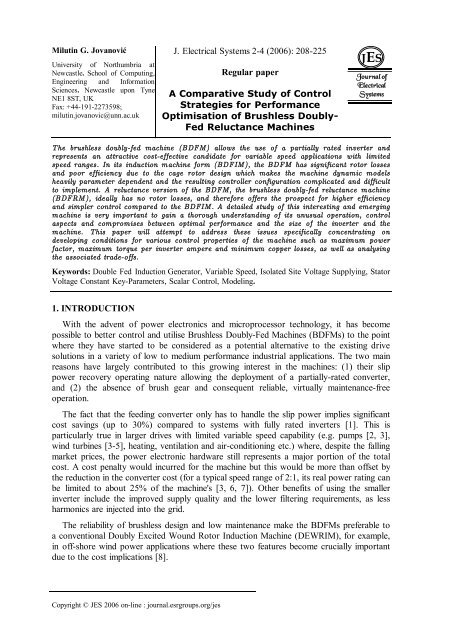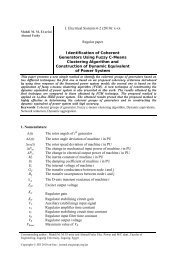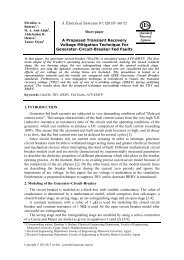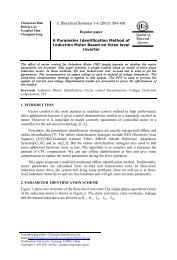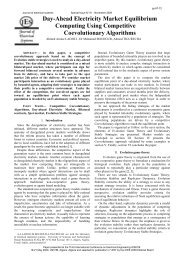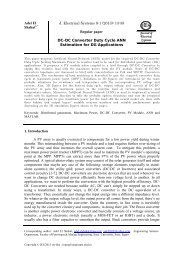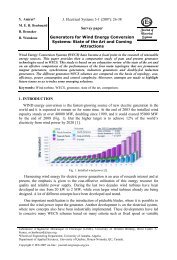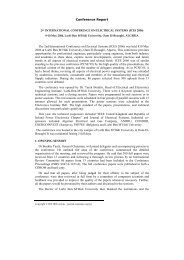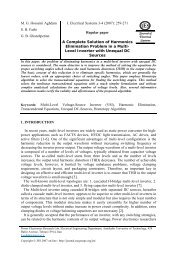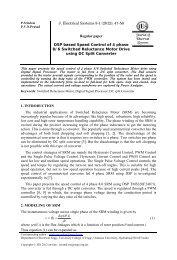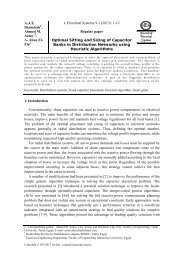A Comparative Study of Control Strategies for Performance ...
A Comparative Study of Control Strategies for Performance ...
A Comparative Study of Control Strategies for Performance ...
You also want an ePaper? Increase the reach of your titles
YUMPU automatically turns print PDFs into web optimized ePapers that Google loves.
Milutin G. JovanovićUniversity <strong>of</strong> Northumbria atNewcastle. School <strong>of</strong> Computing,Engineering and In<strong>for</strong>mationSciences. Newcastle upon TyneNE1 8ST, UKFax: +44-191-2273598;milutin.jovanovic@unn.ac.ukJ. Electrical Systems 2-4 (2006): 208-225Regular paperA <strong>Comparative</strong> <strong>Study</strong> <strong>of</strong> <strong>Control</strong><strong>Strategies</strong> <strong>for</strong> Per<strong>for</strong>manceOptimisation <strong>of</strong> Brushless Doubly-Fed Reluctance MachinesJESJournal <strong>of</strong>ElectricalSystemsThe brushless doubly-fed machine (BDFM) allows the use <strong>of</strong> a partially rated inverter andrepresents an attractive cost-effective candidate <strong>for</strong> variable speed applications with limitedspeed ranges. In its induction machine <strong>for</strong>m (BDFIM), the BDFM has significant rotor lossesand poor efficiency due to the cage rotor design which makes the machine dynamic modelsheavily parameter dependent and the resulting controller configuration complicated and difficultto implement. A reluctance version <strong>of</strong> the BDFM, the brushless doubly-fed reluctance machine(BDFRM), ideally has no rotor losses, and there<strong>for</strong>e <strong>of</strong>fers the prospect <strong>for</strong> higher efficiencyand simpler control compared to the BDFIM. A detailed study <strong>of</strong> this interesting and emergingmachine is very important to gain a thorough understanding <strong>of</strong> its unusual operation, controlaspects and compromises between optimal per<strong>for</strong>mance and the size <strong>of</strong> the inverter and themachine. This paper will attempt to address these issues specifically concentrating ondeveloping conditions <strong>for</strong> various control properties <strong>of</strong> the machine such as maximum powerfactor, maximum torque per inverter ampere and minimum copper losses, as well as analysingthe associated trade-<strong>of</strong>fs.Keywords: Double Fed Induction Generator, Variable Speed, Isolated Site Voltage Supplying, StatorVoltage Constant Key-Parameters, Scalar <strong>Control</strong>, Modeling.1. INTRODUCTIONWith the advent <strong>of</strong> power electronics and microprocessor technology, it has becomepossible to better control and utilise Brushless Doubly-Fed Machines (BDFMs) to the pointwhere they have started to be considered as a potential alternative to the existing drivesolutions in a variety <strong>of</strong> low to medium per<strong>for</strong>mance industrial applications. The two mainreasons have largely contributed to this growing interest in the machines: (1) their slippower recovery operating nature allowing the deployment <strong>of</strong> a partially-rated converter,and (2) the absence <strong>of</strong> brush gear and consequent reliable, virtually maintenance-freeoperation.The fact that the feeding converter only has to handle the slip power implies significantcost savings (up to 30%) compared to systems with fully rated inverters [1]. This isparticularly true in larger drives with limited variable speed capability (e.g. pumps [2, 3],wind turbines [3-5], heating, ventilation and air-conditioning etc.) where, despite the fallingmarket prices, the power electronic hardware still represents a major portion <strong>of</strong> the totalcost. A cost penalty would incurred <strong>for</strong> the machine but this would be more than <strong>of</strong>fset bythe reduction in the converter cost (<strong>for</strong> a typical speed range <strong>of</strong> 2:1, its real power rating canbe limited to about 25% <strong>of</strong> the machine's [3, 6, 7]). Other benefits <strong>of</strong> using the smallerinverter include the improved supply quality and the lower filtering requirements, as lessharmonics are injected into the grid.The reliability <strong>of</strong> brushless design and low maintenance make the BDFMs preferable toa conventional Doubly Excited Wound Rotor Induction Machine (DEWRIM), <strong>for</strong> example,in <strong>of</strong>f-shore wind power applications where these two features become crucially importantdue to the cost implications [8].Copyright © JES 2006 on-line : journal.esrgroups.org/jes
S. Drid et al: Doubly Fed Induction Generator Modeling and Scalar <strong>Control</strong>led <strong>for</strong> Supplying...The above equations can be significantly simplified (especially the primary ones) bychoosing the generic reference frame dpq pto be aligned with the primary flux vector ( lp).This is a natural choice as the grid-connected (primary) winding is <strong>of</strong> fixed line frequencyand approximately constant flux magnitude (as Rpip
J. Electrical Systems 2-4 (2006): 208-225where z = Lp/ Lps(see Appendix inductances). There<strong>for</strong>e, in order to minimise isdandhence maximise torque per inverter ampere under MCL conditions one needs to increaseRs/ Rpratio which, given (20) <strong>of</strong> Appendix 3 resistances, translates to: ns ³ np, As £ Apand p < q . It should be noted that the observation about the windings turns per polerelationship <strong>for</strong> improved torque per ampere per<strong>for</strong>mance ( n / n ³ 1) is consistent withthat made earlier.- Another important comment about the MCL control strategy is that, unlike all the othersconsidered previously, it is the only one affected by the windings pole-numbers. Thisdependence is introduced via the stator resistances (see (12) and (15)) and it means that itdoes matter which winding is a power winding and which one has a control function. Issuesrelated to this are the subject <strong>of</strong> the subsequent sections.sp3. CONTROL PROPERTIES AND TRADE-OFFSThe following analysis shall assume that the BDFRM windings have the same number <strong>of</strong>effective turns per pole ( ns= np) i.e. Lp = Lsand the same gauge copper wire i.e. thesame cross section ( A = A ). It will be based on the machine's normalised expressions inspTable 1 <strong>of</strong> Appendix 2 normalisations. A 6/2-pole machine with a 4-pole rotor shall beconsidered assuming k = 1/ z = 7 / 9 (equivalent to a typical Syncrel rotor saliency ratio<strong>of</strong> 8 [6]).3.1 Constant torque operationpsFig. 3 demonstrates the machine's ability to control primary (and secondary) power factorfrom leading to lagging via the secondary current angle. Notice that <strong>for</strong> a < a ( » 26ounder the conditions assumed) both power factors decrease towards zero as the primarywinding is generating large amounts <strong>of</strong> reactive power into the grid, this being taken by thesecondary winding from the inverter. It can be seen in Fig. 4 that in order to maintain theconstant flux operation <strong>of</strong> the machine in this region the a angle increases to counteractthe flux increasing effect <strong>of</strong> decreasingasangles. Ifaps s uppfssuppf> a , then the primary powerfactor again deteriorates but with the primary now absorbing reactive power from the mainssupply to flux the machine. The secondary power factor consequently improves reaching itsmaximum at a » 110o when the primary winding becomes fully responsible <strong>for</strong> the fluxs uspfproduction and theapvalues are small as shown in Fig. 4.The impact <strong>of</strong> secondary current angle variations and winding pole-numbers on themachine's copper losses can be understood from Fig. 5. It can be seen that <strong>for</strong> the p > qpole-pair combination (dashed curve) the MCL current angle is smaller than in p < q case(solid line) indicating a higher d -axis secondary current ( isdn) and inverter currentloading in the first case. This means that the torque per ampere is better under p < qcondition which con<strong>for</strong>ms with the remark made earlier. At lower asangles both curvesshow a sharp increase <strong>of</strong> losses due to dominant secondary currents. The losses, asexpected, are higher when p < q since Rs > Rpand ip
S. Drid et al: Doubly Fed Induction Generator Modeling and Scalar <strong>Control</strong>led <strong>for</strong> Supplying...10.8capacitive= 0 Q pinductiveinductive= 0 Q scapacitivePower Factor0.60.40.2SecondaryPrimary00 20 40 60 80 100 120 140Secondary current angle[degs]Fig. 3. Winding power factors <strong>for</strong> T n = 1 .180160Primary current angle [degs]1401201008060402000 20 40 60 80 100 120 140Secondary current angle [degs]Fig. 4. Current angle relationship at T n = 12.62.42.2P cu/ P cu-min: p=1,q=3P cu/ P cu-min: p=3,q=1P cu(p=1,q=3) / P cu(p=3,q=1)Copper loss ratio21.81.61.41.210.820 30 40 50 60 70 80 90Secondary current angle [degs]Fig. 5. Effects <strong>of</strong> winding pole-number combinations on copper losses at 1-pu torque3.2 Optimal control aspects at various torque levelsThe plots <strong>of</strong> (13), (14) and (15), <strong>for</strong> maximum power factor and minimum copper lossstrategies implemented in a torque controller, are presented in Fig. 6. The fact that theUSPF secondary current has a demagnetising effect (as a > p /2 i.e. i < 0 ) meansthat a significant extra d -axis current is needed in the primary to preserve constant flux inthe machine. As a result, the USPF pni is about 2.5 its UPPF value (Fig. 7) at 1-pu torque,the ratio being even higher at lower torques when most <strong>of</strong> the USPF current is fluxs uspfsd uspf216
J. Electrical Systems 2-4 (2006): 208-225producing (note the virtually flat curve in this torque range) and the UPPF current (acoupled isqnas a = p /2 and ipdn= 0 ) is small. Note from Fig. 6 that the UPPFp uppfangles are the smallest <strong>of</strong> all as the secondary current is then entirely responsible <strong>for</strong> themachine magnetization and its d -axis component is at its largest.140120Secondary current angle [degs]100806040UPPFUSPFMCL (p=1,q=3)MCL (p=3,q=1)2000 0.2 0.4 0.6 0.8 1 1.2 1.4 1.6Torque [PU]Fig. 6. Optimal control angles at various torque levels1.8Primary Current [PU]1.61.41.210.80.6UPPFUSPFMTPIAMCL (p=1,q=3)MCL (p=3,q=1)0.40.200 0.2 0.4 0.6 0.8 1 1.2 1.4 1.6Torque [PU]Fig. 7. Primary winding currents under optimal conditions1.81.61.4Secondary Current [PU]1.210.80.60.40.2UPPFUSPFMTPIAMCL (p=1,q=3)MCL (p=3,q=1)00 0.2 0.4 0.6 0.8 1 1.2 1.4 1.6Torque [PU]Fig. 8. Secondary winding currents <strong>for</strong> considered control methodologiesFrom Fig. 6 one can also notice the higher values <strong>for</strong> the minimum copper loss (MCL)angles at any torque when p < q . This indicates the lower secondary current magnitudes(at least 20%) compared to the p > q case as shown in Fig. 8. There<strong>for</strong>e, as far as the217
S. Drid et al: Doubly Fed Induction Generator Modeling and Scalar <strong>Control</strong>led <strong>for</strong> Supplying...torque per inverter ampere strategy is concerned, the use <strong>of</strong> a high pole winding <strong>for</strong> controlpurposes is a preferable option as a smaller inverter is then needed.10.9Power Factor0.80.70.60.50.4cosφ at cosφ =1p scosφ at cosφ =1s pcosφ at MTPIAscosφ pat MTPIA0.30.20.100 0.2 0.4 0.6 0.8 1 1.2 1.4 1.6Torque [PU]Fig. 9. Power factors <strong>for</strong> different control strategiesAlong the line <strong>of</strong> the previous discussion, it would be interesting to see what influencepower factor control has on the inverter size required <strong>for</strong> a BDFRM drive system. If theUPPF is desired, then the values <strong>of</strong> asare low and the secondary power factor is poor(Figs. 3 and 9) indicating an inefficient use <strong>of</strong> the inverter, the current rating <strong>of</strong> whichwould have to be higher <strong>for</strong> a given torque as illustrated by the top characteristic in Fig. 8.The situation is diametrically opposite under the USPF conditions when the asangles areabove p /2 and the secondary carries less reactive current. One can see in Fig. 8 thati » 0.5iat T = 1 (and less at lower torque values) meaning that at least a halfsnuspfsnuppfnrated inverter can be used in this case. However, the primary power factor is then acompromise and its maximum value is 0.4 approximately (Fig. 9).For the reasons indicated above, similarly to the DEWRIM [19], a line-side bridge(PWM rectifier) <strong>of</strong> the bi-directional supply converter can be used <strong>for</strong> the primary reactivepower (and DC link voltage) regulation, and the machine-side bridge <strong>for</strong> control <strong>of</strong> torqueand secondary reactive power. In either case, one needs to trade <strong>of</strong>f the size (rating) <strong>of</strong> onebridge with the other. It has been shown, however, that optimally designed radiallylaminatedreluctance rotors, as opposed to the axially-laminated counterparts, can <strong>of</strong>fer asignificant overall per<strong>for</strong>mance improvement to the BDFRM (including the power factorincrease) to the extend that it can compete favorably with the DEWRIM <strong>of</strong> similar framesize [13]. Note that the per<strong>for</strong>mance enhancement considered in [13] has been achievedwith machine design parameters and under conditions (which are impossible to representanalytically) different to those assumed in this paper.If the machine is operated at the maximum torque per secondary ampere (MTPSA), theprimary power factor can be slightly improved (Fig. 9) relative to the USPF value and theinverter current rating further reduced (Fig. 8) but at the cost <strong>of</strong> moving away from theoptimum inverter VA i.e. USPF point (Fig. 9).The inverter current loading under MCL conditions <strong>for</strong> p < q is quite close to anoptimum, but only around unity or higher pu torques (Fig. 8). The corresponding primarypower factor is better than the MTPSA value but is still very low (less than 0.6 at 1-putorque) as illustrated in Fig. 10. As expected, the secondary power factor is compromisedrelative to the MTPSA strategy (especially at lower torques) its value being 0.7 at unitytorque as compared to approximately 0.95 under MTPSA conditions.218
J. Electrical Systems 2-4 (2006): 208-225Another important aspect <strong>of</strong> this analysis is to examine the impact <strong>of</strong> the two pole-numbercombinations <strong>of</strong> the windings on the power factor per<strong>for</strong>mance <strong>of</strong> the machine withminimum copper losses. From Fig. 10 it is evident that the secondary power factorincreases with torque <strong>for</strong> p < q (dashed curve), as opposed to p > q (dashed-dotted line).This results from the greater asangles and lower magnetising currents <strong>of</strong> the secondarywinding in the first case (Fig. 6). The situation is opposite <strong>for</strong> primary power factor, due tothe counteracting effect <strong>of</strong> the primary current angles required to maintain constant fluxoperation <strong>of</strong> the machine. This means that a decreases as a angles increase as shown inpFig. 4. As a consequence, <strong>for</strong> a primary power factor control strategy a multi-pole powerwinding and a 2-pole control winding is a better solution.From a viewpoint <strong>of</strong> minimum copper losses in the machine, the p < q case appears toallow lower losses in the torque range up to about 0.95-pu according to Fig. 11. At highertorque values, p > q seems to be more efficient. The differences in losses are morepronounced at very low torques (less than 10%), and hence the overall efficiency may beaffected more significantly, as it has a tendency to decrease at small output powers. At midrange and higher torques, however, these variations are minor (only a few percent), andtheir impact on the machine efficiency is virtually negligible. There<strong>for</strong>e, with respect toefficiency, unless the machine is to be used at low powers relative to its rating, it isirrelevant which winding is grid connected and which is inverter fed.s0.90.8Power Factor at minimum copper losses0.70.60.50.40.30.20.1primary (p=1,q=3)secondary (p=1,q=3)secondary (p=3,q=1)primary (p=3,q=1)00 0.2 0.4 0.6 0.8 1 1.2 1.4 1.6Torque [PU]Fig. 10. Power factor per<strong>for</strong>mance with minimum copper losses1.061.04Pcu min(p=1,q=3) / Pcu min(p=3,q=1)1.0210.980.960.940.920.90 0.2 0.4 0.6 0.8 1 1.2 1.4 1.6Torque [PU]Fig. 11. Influence <strong>of</strong> winding pole-numbers on minimum copper losses219
S. Drid et al: Doubly Fed Induction Generator Modeling and Scalar <strong>Control</strong>led <strong>for</strong> Supplying...10.90.80.7TPSA / MTPSA0.60.50.40.30.20.1UPPFUSPFMCL (p=1,q=3)MCL (p=3,q=1)00 0.2 0.4 0.6 0.8 1 1.2 1.4 1.6Torque [PU]Fig. 12. Torque per secondary ampere at optimum power factors and minimum copper lossesThe final part <strong>of</strong> this paper is a comparative study <strong>of</strong> the control strategies in terms <strong>of</strong>torque per secondary ampere (TPSA) per<strong>for</strong>mance. The plots in Fig. 12 represent the TPSAnormalised to the optimum MTPSA value (corresponding to as= p /2) . The results inthis figure fully match those in Fig. 8. After MTPSA strategy, the TPSA is the highestunder USPF conditions, and it is the lowest at UPPF, when the inverter current loading is amaximum (as follows from Fig. 8). Fig. 12 yet again confirms the previously madeconjecture <strong>of</strong> TPSA values being higher in the case <strong>of</strong> a machine with 2-pole primary and6-pole secondary windings and minimum copper losses.4. CONCLUSIONThis paper has per<strong>for</strong>med a comprehensive comparative analysis <strong>of</strong> the BDFRM's controlproperties and has developed a set <strong>of</strong> useful expressions suitable <strong>for</strong> implementation <strong>of</strong>various optimal control strategies <strong>for</strong> the machine. Aspects <strong>of</strong> power factor regulation andeffects <strong>of</strong> winding pole-numbers on the machine per<strong>for</strong>mance have been particularlyemphasised. The main conclusions/observations that can be made from the presentedresults are:• The inverter current rating would have to be increased approximately twice <strong>for</strong> unityprimary power factor (UPPF) control at the same torque output, as compared to theother strategies considered.• Under the UPPF conditions the secondary power factor is less than 0.3, indicating atleast three times greater inverter kVA requirement <strong>for</strong> a given power output <strong>of</strong> alossless machine. At the unity secondary power factor (USPF) and the minimuminverter kVA, the primary power factor is barely 0.4 .• The maximum torque per secondary ampere and the USPF operating characteristics arequite close, especially at lower torques where they virtually coincide.• All the per<strong>for</strong>mance parameters (except <strong>for</strong> the primary power factor), under minimumcopper losses conditions, generally improve with a two-pole power winding (gridconnected primary) and a multi-pole control winding (inverter-fed secondary). Theprimary power factor is better <strong>for</strong> the opposite situation (i.e. p > q).• The above optimum pole-pair relationship ( p < q)allows lower copper losses andhigher efficiency in the normal torque range, and particularly at smaller torque values.220
J. Electrical Systems 2-4 (2006): 208-225The paper has provided a valuable insight into the operation and optimal control <strong>of</strong> theBDFRM and can serve as a good reference <strong>for</strong> the interested readers wishing to initiateresearch in this direction. The consideration <strong>of</strong> the machine per<strong>for</strong>mance/inverter ratingtrade-<strong>of</strong>fs is important as in the long run the success or failure <strong>of</strong> this interesting andunusual machine will be likely decided by whether the compromise between a largermachine <strong>for</strong> a given output torque, and a smaller size <strong>of</strong> the inverter, lead to a lower systemcost in the target applications.APPENDIX 1Inductance DefinitionsThe BDFRM's inductance 5 relationships listed below have been developed using themethod <strong>of</strong> winding functions [20] with the air-gap parameters as in Fig. 13. Theexpressions derived are, however, more general than those in [20] as they assume thenonzero permeance i.e. finite air-gap width along the rotor q -axis.3 2Primary: Lp =2m0nm pprl + L ülïp ïïïïSecondary: L = m nmprl + L ïïïï3 2s 2 0 s ls3Mutual: Lps =4m0nnn p sprlï ïýïLpnp2mz =L» nps s n ï ïïïm = yL d+ (1 -y)Lqï ïïïïnpwhere:lp,s=2p ( Ld -Lq)sinyïþnp, s@effective turns/pole/phase <strong>of</strong> the windingsL@ leakage inductances <strong>of</strong> the windingsr, l @ machine mean radius and axial length1/ L @ minimum air-gap widthd1/ L @ maximum air-gap widthqy @ pole-arc/pole-pitch ratio <strong>of</strong> the rotor (Fig. 13)Fig. 13. Inverse air-gap function <strong>for</strong> a 4-pole reluctance rotor used <strong>for</strong> inductance determination (θ ,some mechanical angle around the stator circumference; θrm , the mechanical angle <strong>of</strong> the rotor highpermeance axis)5 In practice, the actual inductance values can be identified from measurements by applying the <strong>of</strong>f-line testingmethods presented in [14].221
S. Drid et al: Doubly Fed Induction Generator Modeling and Scalar <strong>Control</strong>led <strong>for</strong> Supplying...Table 1 :Normalized control from expressions and base quantitiesi pnlsin assin( ap+ as)= =Primary quantities( 2tan a ) 2 s - Tn + Tn 2 tan2 as2tan a= i + i = 1üï ýÛ tan =i i 0 ï1pn pdn z sdnTntan asa1p 2tan as-Tnpqn-z sqn=ïþ1isdnTnpn=2 n;pn= 1- z= 1-2tan sP T Qacos fi snpPpn Tn tan as= =( )Ppn 2 + Qpn 2 Tn 2 + 4 tan 2 as - 4Tn tan as + Tn2z sin ap zTn 1+tan 2 assin( ap+ as) 2tan as= =sSecondary quantitiessnsn= w2 n= wsn pn= -pnP T P sPQf=éT ( - 1)(tan a + 1) + 2tan aùëûúwsnTn12sn 2 24tan a ê n s ss kpss2 2-1 Q1 (1/ 1)(tan 1) 2tansn- Tn kps - as + + asPtan2sn2tan as= tan =Torque, power output and copper losses2 2T = i = i sinn z sqn z snasP = P + P = T = w T1+wsnn pn sn 2 n rn nP cunP=2 2 2( - ) + ( + )( + )4rp tan as tan as Tn Tn rp rs z tan as124tan as2( + z ) + 4= P ( a ) =mcl24( p + sz)2 2 2rp rs Tn rr p szcunmincun s r rTorque & power :Base values23 lp 2wpTBB= 4 r Lpp B=rT p PCurrent & flux : i = l / L l = v / wB B p B B pAPPENDIX 2NormalisationsIn order to make machine per<strong>for</strong>mance expressions independent <strong>of</strong> its parameters a set <strong>of</strong>normalisations corresponding to the arbitrary chosen a = a = p / 4 condition has beendeveloped taking the grid voltage and frequency as bases (see Table 1).psAPPENDIX 3Stator resistance expressionConsider a single full-pitch turn <strong>of</strong> a generic P -pole sinusoidally distributed winding. Thetotal length and resistance <strong>of</strong> the turn are:-222
J. Electrical Systems 2-4 (2006): 208-225lRtt2pd= length in slots + end turn length = 2l+Prcult 2rcu pd2rcudp= = ( l + ) = ( b + )A A P A Pwhere:rd @ diameter from the centre <strong>of</strong> the stator slotscul @ length <strong>of</strong> the machine stack@ resistivity <strong>of</strong> conductive material (copper)A @ cross-sectional area <strong>of</strong> the wire usedb = l/ d @ machine's aspect ratioIf the winding has n effective turns per pole and phase then its total phase resistance is:-2rcudR = P× nRt= nP ( b + p)AApplying this to the BDFRM windings and assuming b » 0.5 <strong>for</strong> convenience (aNEMA180 frame), then the resistances <strong>of</strong> the 2q -pole secondary and 2p -pole primarywinding can be related as follows:-Rsn As p q + p= × ×R n A p + pp p sREFERENCES[1] Y. Liao, Design <strong>of</strong> a brushless doubly-fed induction motor <strong>for</strong> adjustable speed driveapplications, Proceedings <strong>of</strong> the IAS Annual Meeting, pp. 850–855, San Diego, Cali<strong>for</strong>nia,October 1996.[2] B. Gorti, D. Zhou, R. Spée, G. Alexander, and A. Wallace, Development <strong>of</strong> a brushless doublyfedmachine <strong>for</strong> a limited speed pump drive in a waste water treatment plant, Proc. <strong>of</strong> the IEEE-IAS Annual Meeting, pp. 523–529, Denver, Colorado, October 1994.[3] M. G. Jovanovic, R. E. Betz, and J. Yu, The use <strong>of</strong> doubly fed reluctance machines <strong>for</strong> largepumps and wind turbines, IEEE Transactions on Industry Applications, vol. 38, pp. 1508–1516,Nov/Dec 2002.[4] L. Xu and Y. Tang, A novel wind-power generating system using field orientation controlleddoubly-excited brushless reluctance machine, Proc. <strong>of</strong> the IEEE IAS Annual Meeting, Houston,Texas, October 1992.[5] O. Ojo and Z. Wu, Synchronous operation <strong>of</strong> a dual-winding reluctance generator, IEEETransactions on Energy Conversion, vol. 12, pp. 357–362, December 1997.[6] R. E. Betz and M. G. Jovanovic, The brushless doubly fed reluctance machine and thesynchronous reluctance machine - a comparison, IEEE Transactions on Industry Applications,vol. 36, pp. 1103–1110, July/August 2000.[7] R. E. Betz and M. G. Jovanovic, Introduction to the space vector modelling <strong>of</strong> the brushlessdoubly-fed reluctance machine, Electric Power Components and Systems, vol. 31, pp. 729–755,August 2003.223
J. Electrical Systems 2-4 (2006): 208-225[26] B. Hopfensperger, D. J. Atkinson, and R. A. Lakin, Stator flux oriented control <strong>of</strong> a cascadeddoubly-fed induction machine, IEE Proc. - Electr. Power Appl., vol. 146, pp. 597–605,November 1999.[27] L. Xu and W. Cheng, Torque and reactive power control <strong>of</strong> a doubly fed induction machine byposition sensorless scheme, IEEE Transactions on Industry Applications, vol. 31, pp. 636–642,May/June 1995.[28] L. Morel, H. Godfroid, A. Mirzaian, and J. M. Kauffmann, Double-fed induction machine:Converter optimisation and field oriented control without position sensor, IEE Proc. - Electr.Power Appl., vol. 145, pp. 360–368, July 1998.225


